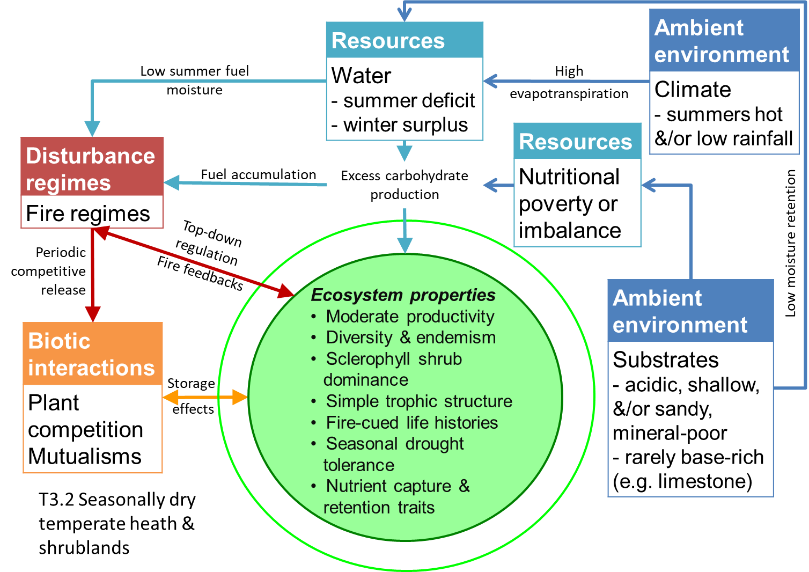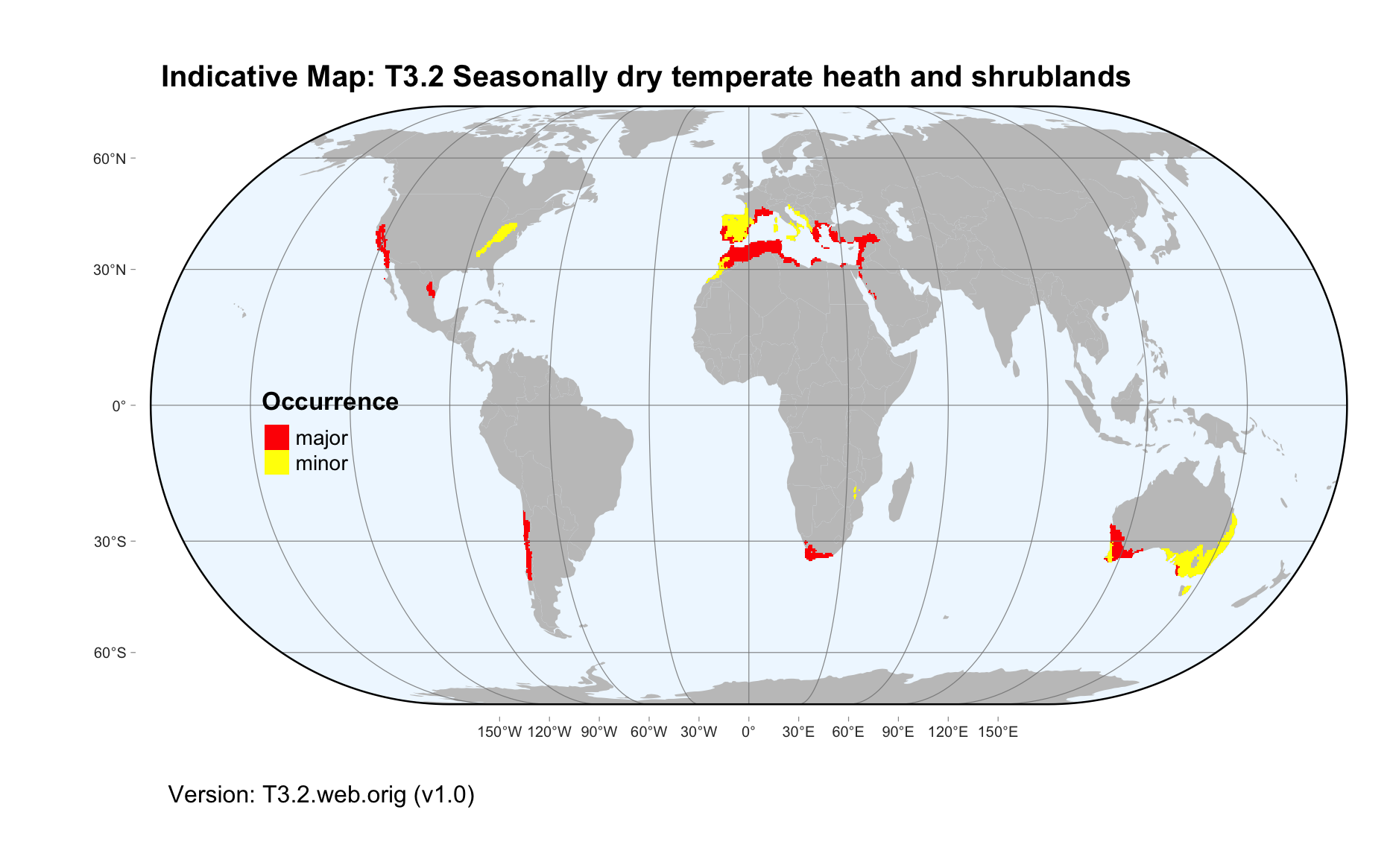Global ecosystem typology
Alternative site for the Global ecosystem typology with additional information for ecosystem profiles and indicative maps.
This site is maintained by jrfep
T3.2 Seasonally dry temperate heath and shrublands
Biome: T3. Shrublands and shrubby woodlands biome
Contributors:
(texts)
These temperate ecosystems are dominated by sclerophyll shrubs with small or ericoid leaves. A low sparse tree canopy may or may not be present. Low-moderate productivity is limited by summer droughts and low nutrient availability. and sandy or loamy soils, with many diverse plant specialisations to low nutrient, and regular fires, accelerated by slow decomposition rates. Foodwebs vary from complex to simple, but most lack large herbivores and predators. Vertebrate herbivores have specialisations to exploit low nutrient vegetation and avoid recurring fires, which are influential on plant and animal life histories. Specific plant-invertebrate relationships (e.g. as larval hosts and pollinators) are common (moths and butterflies larval hosts, wasp pollinators).
Key Features
Sclerophyll evergreen shrublands of humid and subhumid mid-latitudes with a canopy-fire regime.
Overview of distribution
Temperate regions adjacent to cold ocean currents with summer dry season.
Profile versions
- v1.0 (2020-01-20): DA Keith
- v2.0 (2020-05-31): DA Keith; J Loidi
- v2.01 ():
- v2.1 (2022-04-06): DA Keith; J Loidi Full profile available at official site
Main references
Selected references for this functional group:
Lamont BB, Keith DA (2017) Heathlands and associated shrublands Australian vegetation (Ed. DA Keith), pp 339-368. Cambridge University Press, Cambridge. ISBN 978-1-107-11843-0
Keeley JE, Bond WJ, Bradstock RA, Pausas, JG, Rundel PW (2012) Fire in Mediterranean Ecosystems: ecology, evolution and management Cambridge University Press, Cambridge
Diagrammatic assembly model

Maps
Maps are indicative of global distribution patterns are not intended to represent fine-scale patterns. The maps show areas of the world containing major (coloured red) or minor occurrences (coloured yellow) of each ecosystem functional group. See general notes on maps.
There are 2 alternative versions of the indicative map for this functional group, please compare description and sources below.
T3.2.IM.orig_v1.0
Datasets
- Resolve-Ecoregions-2017
Map references
Dinerstein E, Olson D, Joshi A, Vynne C, Burgess ND, Wikramanayake E, Hahn N, Palminteri S, Hedao P, Noss R, Hansen M, Locke H, Ellis EE, Jones B, Barber CV, Hayes R, Kormos C, Martin V, Crist E, Sechrest W, Price L, Baillie JEM, Weeden D, Suckling K, Davis C, Sizer N, Moore R, Thau D, Birch T, Potapov P, Turubanova S, Tyukavina A, de Souza N, Pintea L, Brito JC, Llewellyn Barnekow Lillesø JP, van Breugel P, Graudal L, Voge M, Al-Shammari KF, Saleem M (2017) An Ecoregion-Based Approach to Protecting Half the Terrestrial Realm, BioScience 67: 534–545. DOI:10.1093/biosci/bix014. Data-set available on-line
T3.2.web.orig_v1.0

Datasets
- Resolve-Ecoregions-2017
Map references
Dinerstein E, Olson D, Joshi A, Vynne C, Burgess ND, Wikramanayake E, Hahn N, Palminteri S, Hedao P, Noss R, Hansen M, Locke H, Ellis EE, Jones B, Barber CV, Hayes R, Kormos C, Martin V, Crist E, Sechrest W, Price L, Baillie JEM, Weeden D, Suckling K, Davis C, Sizer N, Moore R, Thau D, Birch T, Potapov P, Turubanova S, Tyukavina A, de Souza N, Pintea L, Brito JC, Llewellyn Barnekow Lillesø JP, van Breugel P, Graudal L, Voge M, Al-Shammari KF, Saleem M (2017) An Ecoregion-Based Approach to Protecting Half the Terrestrial Realm, BioScience 67: 534–545. DOI:10.1093/biosci/bix014. Data-set available on-line
Check: the Glossary / Profile structure / the public document